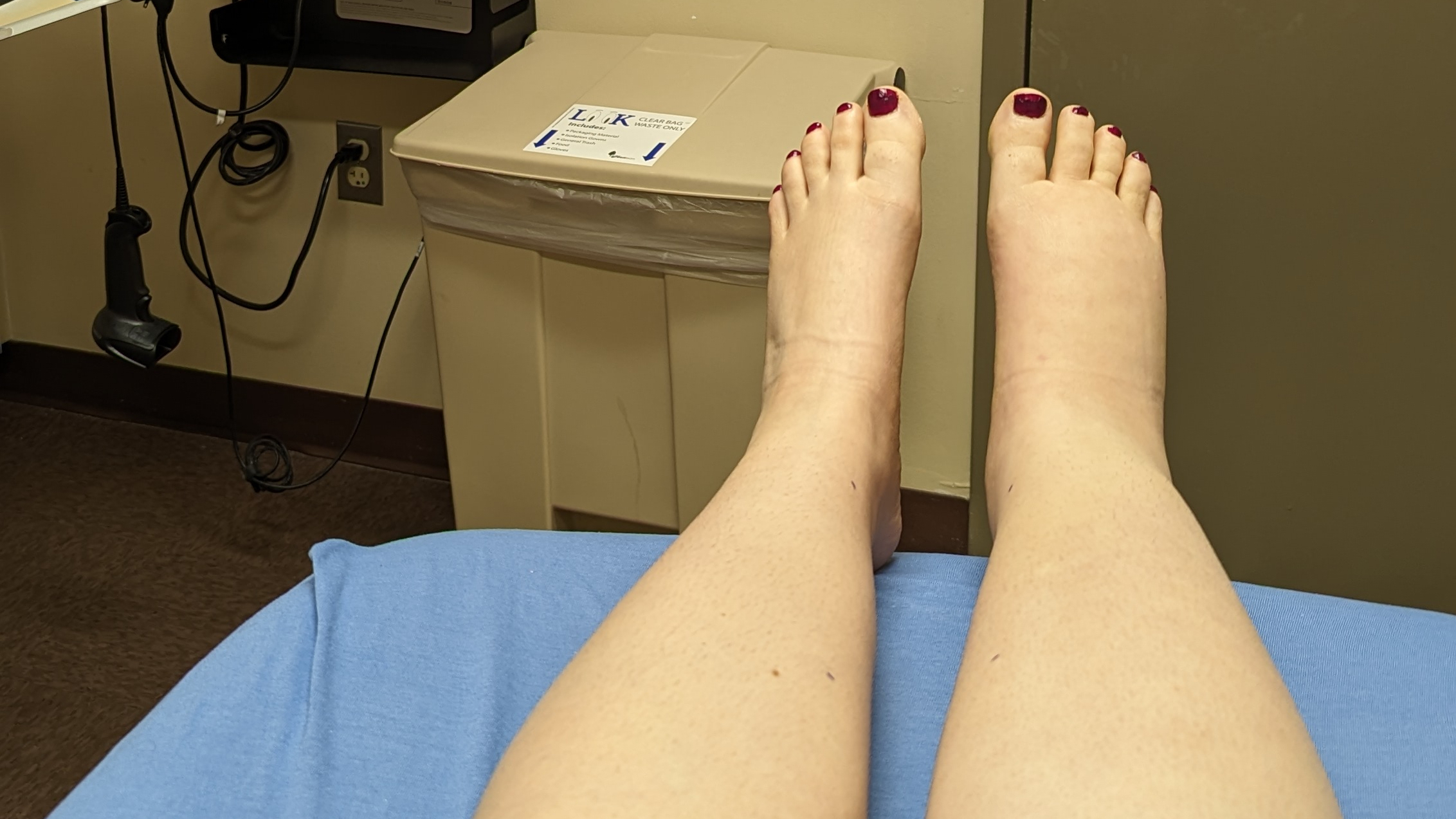One of the first things we learn when diagnosed with lymphedema is that there’s no cure, no magic pill to make this go away. That realization can be devastating—like you just received a life sentence—and it’s true: there is no cure. However, there are a number of treatment options to help manage lymphedema and keep the swelling under control!
It’s important to note that treatment regimens do not reverse the symptoms or repair the lymphatic system; to treat lymphedema is to control the swelling and prevent it from worsening. It’s also very much our responsibility to carry out our treatment, because most lymphedema treatment and management involves daily care.
In this way it certainly can feel like a life sentence, but if you reframe it as a part of your daily routine—wake up, brush my teeth, don my compression garment, drink my coffee—it may begin to feel less of an annoying obligation and more of a regular habit.
Treatment Options
It’s incredibly important for patients to seek help at the very first sign of symptoms, because early diagnosis and treatment can improve the overall prognosis: the sooner you get started with a treatment regimen, the better control you can have over your swelling.
When prescribing treatment, a doctor or lymphedema therapist will take into account your particular case of lymphedema before going over your options for treatment. Certain treatments—like a pneumatic compression device, for example—may be okay for one person but not okay for another, based on their severity of swelling or the cause of their lymphedema (primary, secondary, cancer-related). Although much of lymphedema treatment lies in your own hands in order to be effective, your doctor or lymphedema therapist will follow up with you to make sure you’re responding to the treatment, or if any modifications or adjustments need to be made. Always, always check with your team before changing anything!
Treatment is often a combination of a variety of methods; drugs and medication are not usually used in long-term treatment of lymphedema, except when in the case of treating infections. Some of common forms of treatment as outlined by the National Lymphedema Network are as follows:
- Compression garments provide gradient pressure to move lymph fluid. Usually it’s recommended to have at least two garments, so that you have one to wear while one is being washed—garments need to be washed daily to prevent infections and maintain compression! In addition to day garments, there are also options for garments worn during the night. The style and compression strength of a garment are dependent on what part of the body is affected and the volume of the swelling. Garments can be custom-fit, although they are available in ready-made sizes and over-the-counter.
- Compression bandaging is the strategic application of multiple layers of materials (usually foam padding and short-stretch bandages) to create effective gradient compression on the affected limb. Your lymphedema therapist can demonstrate how to wrap your affected limb properly so that you can do it at home, either by yourself or with the help of a family member or loved one.
- Manual lymph drainage (MLD) is a specialized massage technique that stimulates lymph flow from congested areas into functioning lymph vessels and lymph nodes. It is learned by certified lymphedema therapists, and often taught to patients so that they can perform it at home.
- Exercise, when cleared by a doctor or lymphedema therapist, is beneficial for all patients as it promotes healthy lymph flow. Gentle exercises like swimming, cycling, yoga, and walking are especially good for you! Talk to your lymphedema team to see which exercises would be most appropriate for your lymphedema and how you can incorporate them into your treatment program, and always be sure to wear your compression garments during exercise to minimize any exacerbation of swelling that can occur.
- Weight loss and maintenance are important aspects of lymphedema treatment, as lymphedema worsens with obesity. Talk to your doctor or lymphedema therapist about how this pertains to your treatment, and what are some safe ways you can maintain a healthy weight.
- Pneumatic compression devices or compression pumps can be extremely beneficial for some patients, especially as a component of their home treatment program. There are a number of considerations to take into account before getting a compression pump, however, including an evaluation by your healthcare provider to make sure that a pump would be appropriate for you and your treatment. If you are interested in using a compression pump, talk to your lymphedema therapist first!
- Surgical treatments are not curative, but are used in certain circumstances, usually with severe cases. These types of surgeries include debulking surgery, liposuction, tissue transfers, and microsurgical lymphatic reconstruction. However, there are significant risks associated with surgery and it is not usually covered by insurance. It also does not negate the need for compression garments and other lymphedema maintenance techniques afterwards.
- Pharmaceutical approaches such as diuretics are not usually effective in removing interstitial fluid from body tissue. If a patient has other medical conditions (such as high blood pressure or heart disease) then medications must be assessed on a case-by-case basis. It’s important to maintain communication among your healthcare team so as to ensure the best treatment for your entire health and well-being!
Management
A lot of lymphedema management comes down to being consistent and compliant with your treatment, so it’s really important to make your lymphedema treatment a part of your daily routine.
It’s normal to feel resentful towards your lymphedema for having to take time out of your day to do these things—and it does require a lot of time—but you can challenge this by creating positive associations with your treatment and reframing it as something to look forward to rather than dread. For example, when I do my hour-long compression pump treatments, I use it as time to catch up on the latest episode of my favorite TV show. When I get ready in the morning, I put on some upbeat music to get me in a good mood as I dance and wiggle my way into my compression stocking. When I need to elevate my leg for a while, I set myself up on the couch with a bunch of pillows for my leg, and a good movie or book for my own entertainment. A lot of my lymphedema management is considered “me time,” time that I look forward to as an opportunity to be gentle with myself and maintain my health.
Living with lymphedema can often feel like things are out of our control and that our bodies are acting against us, but what is in our control is how we take care of ourselves and our health. It’s easy to feel unmotivated or hopeless in the face of the daily requirements of lymphedema treatment, and we may find ourselves asking what’s the point. Well—our health, well-being, and quality of life is the point! It’s so important that we fight complacency and stay active with our treatment.
Precautions
There are a number of precautions you can take in order to keep your lymphedema from worsening, and it’s a good idea to establish them as daily habits. It’s important to be mindful of these things because although they may seem small or inconsequential, they go a long way in maintaining your lymphatic health!
Take care of your skin. Any breaks in the skin (cuts, scratches, bug bites, etc) create an opportunity for bacteria to enter the body, and the protein-rich lymph fluid stagnating in your tissues due to lymphedema is the perfect environment for this bacteria to grow and cause infection. No good! To help prevent this, use cream or lotion to keep your skin moisturized, keep your nails clean and cared for, and treat any small cuts or skin breaks immediately. When outdoors, wear shoes and sunscreen, and gloves if you’re gardening.
Don’t cut off your circulation. Lymph flow is passive, which means it’s up to our body’s movement to keep the lymph flowing like it’s supposed to. This is especially important in the affected limbs, so be mindful not to block flow. If you’ve got lymphedema in your legs, don’t cross your legs while sitting—if you do, keep the affected limb on top, and cross at the ankle—and be sure to change your sitting position every half hour if you can. If you’ve got lymphedema in your arms, don’t carry heavy bags on your affected limb. Also, tight clothing or jewelry can obstruct lymph flow no matter what part of the body is affected, so opt for looser styles when possible!
Stay elevated. Whenever possible, keep your affected limb elevated. Higher than the heart is the rule, but if that’s not an option, any bit of elevation helps to fight gravity and prevent the fluid from pooling in the affected limb. And, of course, I like to say that “Stay Elevated” refers not just to your limb, but to your attitude, too. Keeping a positive outlook can really do wonders!
Check out the Tips & Tricks category of the site for posts with even more ways to keep your swelling under control, and be sure to talk with your doctor or lymphedema therapist about your treatment options!
Support World Lymphedema Day
 There are a number of ways you can help support World Lymphedema Day and show your solidarity! In addition to signing and sharing the petition, you can add a banner to your social media profile photos, or post your support on Twitter. These seemingly small gestures can inspire meaningful conversation about lymphedema and the need for awareness!
There are a number of ways you can help support World Lymphedema Day and show your solidarity! In addition to signing and sharing the petition, you can add a banner to your social media profile photos, or post your support on Twitter. These seemingly small gestures can inspire meaningful conversation about lymphedema and the need for awareness!
You can also support lymphatic research by donating to one of the research organizations, such as the Lymphatic Education & Research Network or the National Lymphedema Network, or by getting involved in the upcoming Lymphedema Lobby Days in D.C. this April.
Check out last year’s post for even more ideas on how to promote lymphedema awareness!
Keep checking back for more helpful information about lymphedema and lymphedema awareness throughout the week as we get closer to establishing the first-annual World Lymphedema Day on March 6th!




Leave a Reply